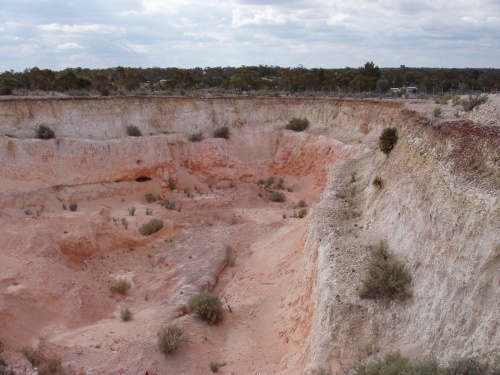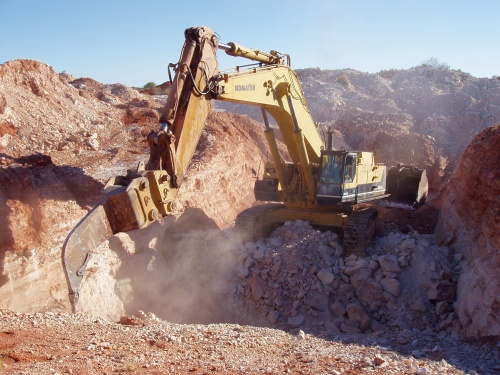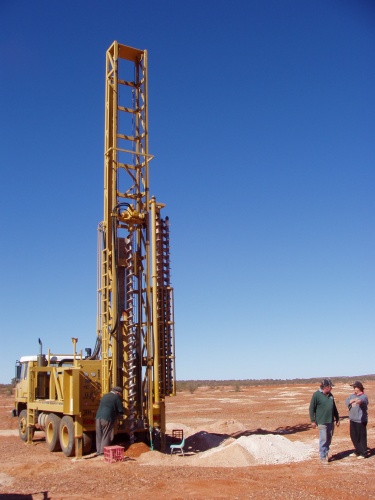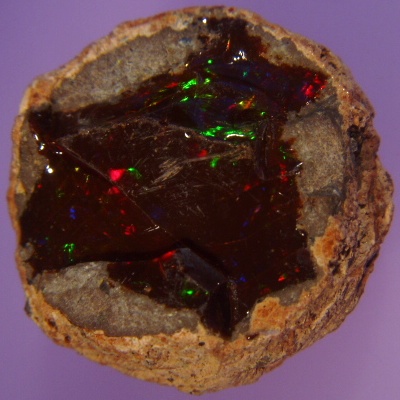Australian Opal Fields
Australia is the world's largest and most important producer
of
opal. Around 95 % of the world's production come out of Australian
opal fields.
Australian opals are usually of sedimentary origin and considered particularly
stable. There are also some opal mining fields in Australia that produce opal of volcanic
origin (e.g. Tintenbar, NSW). However these are only of interest for collectors
but of no importance for the jewelry sector. Some of the most important and
famous mining fields are displayed on the opal origin map below:

Today the opal production has decreased compared to its heyday due to increased
fuel costs, restrictions on the use of explosives and an antiquated mining law.
In addition many of the old opal mining fields are already well mined not to say mined out
and the prospecting for new opal fields is an expensive work. Therefore only a few
full-time miners are left and concentrated around the most important localities
like
Lightning Ridge,
Coober Pedy,
Mintabie,
Lambina and
Queensland.
 |
|
Danger signs and uncountable
hummocks from underground
mining are bordering the Stuart Highway around Coober Pedy |
The opal mining field of Coober Pedy lies at the Stuart Highway, 750 km north
of Adelaide. A 14-year old boy who was camping with his father's gold
prospecting party discovered opal in 1915 as well as a waterhole that saved
their lives.
The name Coober Pedy was derived from the Aboriginal kupa piti meaning
"white man in a hole" (or "boy's waterhole" if you read some other texts). The
population is around 2500. Due to unbearable summer temperatures which may
exceed 50°C most people are living underground in so called "dugouts".
Mining is usually done by underground tunneling. The opal dirt (mullock) is
conveyed to the surface by blowers or automatic bucket tippers.
Most opal found is
Light
Opal and
Crystal Opal. However there is also some
Dark
Opal
and very little Black Opal. While most of Coober Pedy opal is seam opal, there
is also a significant part found in the form of
opalized fossils (e.g. shells,
snails, belemnites, bones, teeth and wood).
The mining works extend over an area 50 km long, running approximately parallel
to the Stuart Highway from north to south. Opal is found in deeply weathered
white to mauve Bulldog Shale of cretaceous age. Within the light, porous host
rock (sandstone), opal may be found as veins in horizontal "levels" or in
steeply dipping "verticals" down to 25 m below the surface. Distribution is
unpredictable and opal may not persist from one claim to the next.
From 1978 to 1990 Coober Pedy produced approximately 20 - 30 million worth of
rough opal annually. In 2002 Coober Pedy's
production has fallen to 25% of its heyday. Today only a limited number of
full-time miners is left. |
 |
|
Lunatic Hill, a huge open-cut at
Lightning Ridge |
This is the home of the world famous Black Opal. Lightning Ridge is
located almost 600 km north of Sydney. First finds of opal around this area date
back to 1873. However it wasn't until 1903 that Charlie Nettleton and Jack
Murray sold their first parcel of Black Opal to E. F. Murphy, an assistant of
the famous Tullie Wollaston who was the main power behind introducing Australian Opal to
the world's market.
Lightning Ridge got its name probably due to a terrifying electrical storm that
killed a shepherd, his dog and 600 sheep whilst sheltering on one of the ridges.
The population is around 3000. However this may quickly change by new
discoveries or a large find which may produce a new rush. So happened in the
late 1980s when the Coocoran field 30 km to the west of the township produced
stunning Black Opal in great quantities. Mining is usually done by underground tunneling. Very rich ground may also be worked by
an open-cut like the famous
Lunatic Hill since it pays to work the entire area completely and enables to
remove and process all opal dirt. With underground mining you will always have
to leave walls and pillars of host rock to prevent a cave-in.
Most opal found is Dark (Semi-black), Black and Crystal Opal as well as some
Light Opal and a few
opalized fossils. Opal around Lightning Ridge is usually found in the form of nodules
called "nobbies". This form is considered to produce the world's highest quality
of opal. Farther outlying fields like Grawin, Glengarry, Sheep Yards,
and Mulga Rush predominantly produce Dark and Black Seam Opal.
Today top-quality Black Opal (brilliant red on black) are the most valuable of
all opals and can fetch record prices sometimes at more per carat than good
quality diamond. Particularly since there is by far not enough quality Black
Opal to satisfy world demand. |
 |
|
Open-cut mining at Mintabie with a
huge 100 tons excavator |
Mintabie, population around 200, is situated 35 km west of Marla off the
Stuart Highway (or about 350 km northwest of
Coober Pedy). Apart from
Lightning
Ridge it is the only important source of Black Opal.
Although opal miners discovered the field in the 1920s, it was only in the 1980s
that production increased to make it a commercial field.
At the end of 1976 miners moved in with bulldozers and heavy mining equipment
which was needed to rip the hard sandstone.
During the 1980s Mintabie was the largest producer of precious opal in Australia
and over 500 miners lived and worked on the field. Fortunes were made in
open-cuts at Old Field. The peak in production was reached at 1988 and
drastically declined in the following years. Up to 100 large bulldozers and many
scrapers and excavators quickly mined out this very rich area. Today only a
small number of full-time miners is left.
Most mining is done by open-cut mining as well as some underground tunneling.
The opal found comprises Light, Dark, Black and Crystal Seam Opal. Mintabie opal
is extraordinary hard, sometimes even hard enough to scratch agate. Host rock is
a kaolinitic sandstone of probable Ordovician age. The opal is found as seams in
horizontal or arcuate levels or infillings of steeply dipping verticals down to
depths of 25 m.
Some people say that during the first 5 years of mining Mintabie produced more
opal than Coober Pedy has to this date. |
 |
|
Prospect drilling at Lambina |
Andamooka
Andamooka is located in the harsh desert, 520 km north of Adelaide, near the
western shore of Lake Torrens. It is reached travelling by sealed road
30 km east from Roxby Downs which today employs much of Andamooka's
population in their uranium mines.
Opal was discovered in 1930 and until 1972 Andamooka was a major
producer of precious opal. It was famous for producing top-quality Crystal
Opal which may occur in the form of seams and so called "blobs" (similar
to nobbies but with sizes up to a small loaf). Additionally
Matrix Opal
and "Painted Ladies" (thin films of opal in joints of quartzite boulders
which are split open parallel to the film of opal) come from Andamooka.
Today this field is worked out with very little
commercial production since the 1970s.
Lambina
Located 58 km northeast of Marla. First workings probably date from the 1930s.
This field has steadily grown when a scheme of arrangement was agreed with the
farming landholder. In 2002 around 300 miners were working open-cuts with bulldozers and
excavators.
Opal is found in the form of Light and Dark Seam Opal as well as some Crystal
and very little Black Opal. However rough material often has a distinct
appearance from classical seam opal forming as
disjointed chunks coated with dirt on all sides why it was sometimes incorrectly
termed alluvial opal. Today there are not so many miners left.
Queensland fields
The fields are spread across 1000 km, covering a large part of the entire state
Queensland. They produce almost all the world's supply of
Boulder Opal. Some of
the most important locations are Yowah, Quilpie, Koroit, Jundah, Opalton and Eromanga. Mining is mostly done by open-cut mining.
Boulder Opal usually is an ironstone rock with thin veins of opal that are too
thin to be cut without retaining a backing of ironstone. Therefore the boulders
are split open or sawn parallel to the vein of opal sometimes producing a
matching pair of opals. It may also happen that the vein of opal is thick enough
to be cut into solid opals. Apart from Boulder Opal there are also large
quantities of
Boulder Matrix Opal found (many fine veins and small patches of
opal surrounded by host rock).
White Cliffs
White Cliffs lies in New South Wales and is situated 200 km northeast of Broken
Hill. The field was discovered by kangaroo shooters in 1889.
Commercial mining commenced in 1890. The town quickly developed and within 9
years there were 4500 miners on the field. The production declined from 1902 to
1915 and a big exodus of miners to the opal fields of Lightning Ridge reduced
the number of miners to 100 by 1919. The main run was worked out by 1930.
For many years White Cliffs produced the first commercially accepted opal and
excited the world's market since this opal far surpassed opal mined in Hungary.
Beside the famous "Pineapples" (pseudomorphs
of opal after glauberite crystal aggregates) White Cliffs produced fine
quality seam opal and
opalized fossils (shells, wood, bones). |
 |
|
Split nodule of Ethiopian opal
(thunder-egg) |
Apart from Australia opal occurs at many other localities around the
world. For example in Brazil, Mexico, Peru, Honduras, Guatemala, Nicaragua,
Grand Canary, USA, Canada, Ethiopia, Zimbabwe, South Africa, Nigeria, Somalia,
Mali, Germany, Czech Republic, Turkey, Kazakhstan, Indonesia and New Zealand.
However only a few of these areas are of limited commercial importance since
around 95 % of the world's production of opal come out of
Australia. |
|